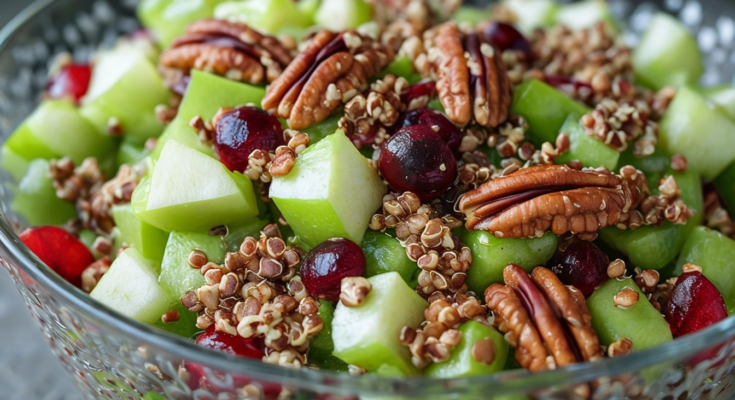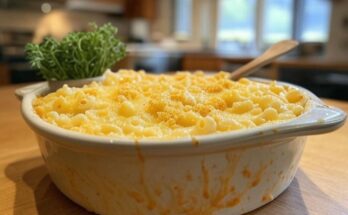Apple salad is a delightful and adaptable dish that showcases the crisp, sweet essence of apples while incorporating a variety of complementary ingredients. From crunchy nuts and fresh vegetables to creamy dressings and tangy fruits, the possibilities are endless. Apple salad can be prepared in both savory and sweet variations, making it suitable for different meals and occasions. Whether served as a light side dish for dinner or as a fruit-based dessert, apple salad provides a harmonious balance of textures and flavors tailored to individual tastes.
Why Make Apple Salad?
Apple salad is not only quick and easy to prepare but also packed with nutritional benefits. Apples are rich in vitamins, particularly vitamin C, and provide a good source of dietary fiber. The salad’s versatility allows for an array of ingredient combinations, making it customizable based on availability and dietary preferences. Whether opting for a creamy, indulgent version or a lighter, healthier alternative, apple salad remains a fresh and crunchy choice suitable for any occasion. It can be enjoyed as a side dish, a light lunch, or even a dessert, adding a nutritious and flavorful element to meals.
The History and Origins of Apple Salad
Origins of Apple Salad
Fruit salads have been enjoyed for centuries, dating back to ancient Roman and Greek times. Apple salad, as a distinct variation, gained popularity in the late 19th and early 20th centuries, particularly in the United States and Europe, where apples were readily available and frequently incorporated into culinary creations. The combination of sweet and savory ingredients allowed apple salad to become a staple in both casual and formal dining settings.
Classic Versions of Apple Salad
One of the most iconic apple salads is the Waldorf Salad, first created at the Waldorf-Astoria Hotel in New York City in 1896. This classic dish originally consisted of fresh apples, celery, and walnuts dressed in a light mayonnaise. Over time, variations emerged, incorporating ingredients such as grapes and raisins, solidifying the Waldorf Salad’s status as a timeless favorite.
Nutritional Benefits of Apple Salad
Rich in Vitamins and Fiber
Apples are a nutritional powerhouse, particularly high in vitamin C, which supports immune function, and vitamin A, which promotes healthy vision and skin. Additionally, apples are an excellent source of dietary fiber, especially pectin, which aids digestion and promotes gut health. By including apples in salads, you enhance both the nutritional value and the satisfying crunch of the dish.
Low in Calories but High in Flavor
Despite their natural sweetness, apples are relatively low in calories, making them an excellent foundation for a healthy salad. When paired with nutrient-rich ingredients such as leafy greens, vegetables, or lean proteins, apple salad becomes a flavorful and filling meal without excessive calories. Using light or homemade dressings further enhances its health benefits.
Add-ins for Nutritional Boost
Apple salad can be made even more nutritious by incorporating ingredients like nuts, which provide healthy fats and protein, or yogurt, which supplies probiotics for gut health. Seeds like chia or flax are excellent additions for omega-3 fatty acids. These combinations not only enhance texture but also contribute essential nutrients, making apple salad a well-rounded dish.
Types of Apples to Use in Apple Salad
Best Apples for Salad
The type of apple used significantly impacts the texture and flavor of the salad. Crisp and firm apples hold up best, maintaining their structure even after slicing. Popular choices include:
- Granny Smith – Known for their tartness, they contrast well with sweet and savory ingredients.
- Honeycrisp – Juicy and sweet with a crisp texture, perfect for fresh salads.
- Fuji – Sweet and firm, adding a pleasant flavor balance.
Balancing Sweetness and Tartness
For a well-balanced apple salad, consider mixing tart apples like Granny Smith with sweeter varieties like Gala or Fuji. This combination enhances the overall flavor profile, especially when paired with creamy or savory ingredients like cheese, nuts, or yogurt-based dressings. Additionally, incorporating a mix of textures, from crunchy apples to smooth dressings, creates a more satisfying dish.
Popular Ingredients in Apple Salad
Core Ingredients
Beyond apples, several ingredients commonly appear in apple salads depending on the desired flavor and texture. Common additions include:
- Celery – Adds a refreshing crunch.
- Nuts (walnuts, pecans, almonds) – Provide richness and contrast in texture.
- Grapes or raisins – Enhance sweetness.
- Lettuce or spinach – Serve as a lighter, greener base.
Dressing Options
The choice of dressing plays a crucial role in apple salad:
- Creamy dressings – Mayonnaise or yogurt-based dressings add richness.
- Vinaigrettes – Olive oil, lemon juice, or apple cider vinegar enhance natural flavors.
- Honey-mustard dressing – Balances sweetness and acidity.
Step-by-Step Guide to Making Apple Salad
Ingredients:
- 2 large apples (such as Granny Smith and Honeycrisp)
- 1/2 cup chopped celery
- 1/2 cup grapes, halved
- 1/4 cup walnuts or pecans, toasted
- 1/4 cup yogurt or mayonnaise
- 1 tablespoon lemon juice
- Salt and pepper to taste
Preparation:
- Prepare the Apples: Wash and core apples, then cut into bite-sized pieces. Toss with lemon juice to prevent browning.
- Combine Ingredients: In a large bowl, mix apples, celery, grapes, and toasted nuts.
- Mix Dressing: Combine yogurt or mayonnaise with salt and pepper, then stir into the salad.
- Serve Fresh: Enjoy immediately or refrigerate for 15-20 minutes for a chilled option.
Apple Salad Recipe Variations
- Classic Waldorf Salad: A traditional mix of apples, celery, grapes, and walnuts with a creamy dressing.
- Apple and Spinach Salad: A healthier version with spinach, feta cheese, sunflower seeds, and balsamic vinaigrette.
- Apple and Chicken Salad: A protein-rich variation with grilled chicken, pecans, and dried cranberries in honey-mustard dressing.
Tips for Storing Apple Salad
- Refrigerate in an airtight container to keep it fresh for up to 1-2 days.
- Toss apples in lemon juice to prevent browning.
- Store dressing separately to maintain crispness.
Serving Suggestions and Pairings
Apple salad is a versatile dish suitable for various occasions, from casual picnics to holiday gatherings. It pairs well with:
- Grilled meats (chicken, pork, steak)
- Sandwiches or wraps
- Soups for a light yet satisfying meal
Common Mistakes to Avoid
- Overdressing: Too much dressing can make the salad soggy.
- Using fast-browning apples: Opt for varieties like Granny Smith or Honeycrisp to maintain freshness.
Frequently Asked Questions (FAQs)
Can I Make Apple Salad Ahead of Time? Yes, but store ingredients separately and assemble before serving to maintain freshness.
What is the Best Dressing for Apple Salad? Creamy dressings pair well with classic variations, while vinaigrettes work best for lighter options.
Can I Use Other Fruits in Apple Salad? Yes! Pears, oranges, strawberries, and blueberries make great additions.
Apple salad’s versatility, flavor, and nutrition make it a delightful dish perfect for any occasion.



